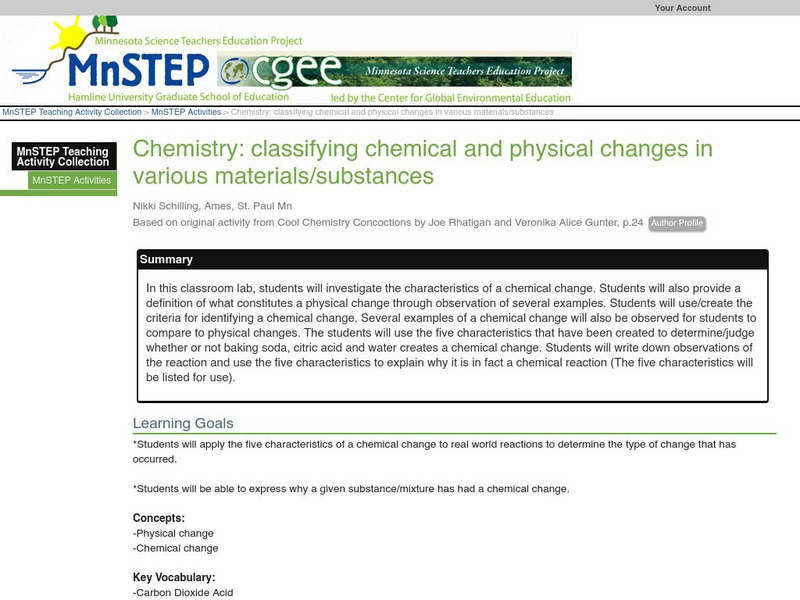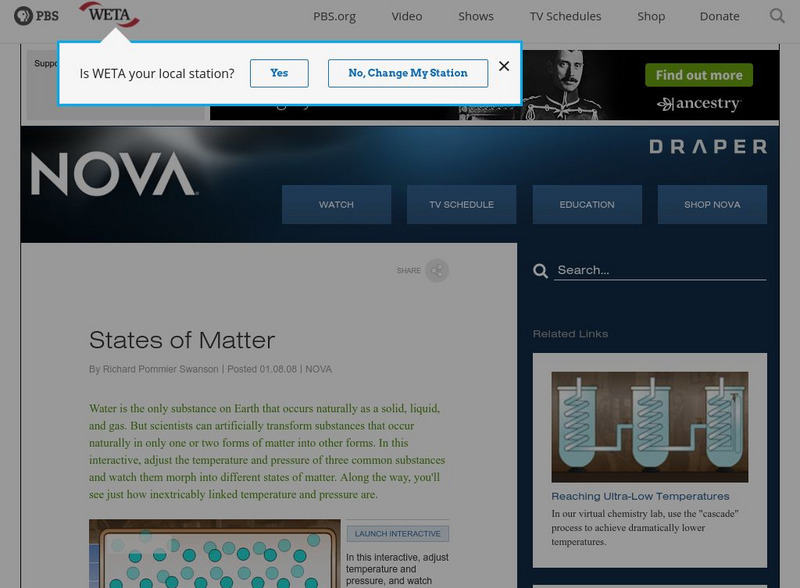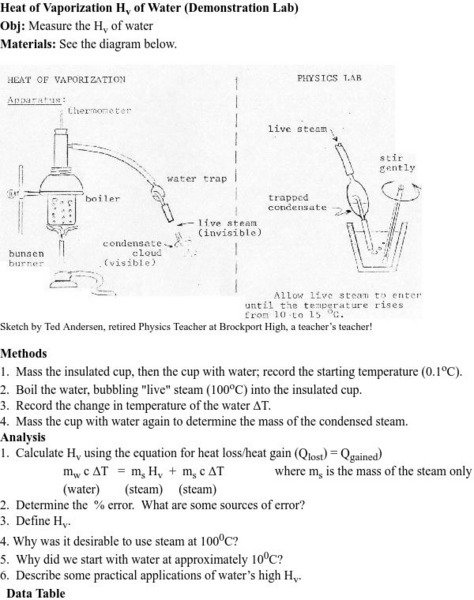Curated OER
Hess's Law
For this reactions worksheet, students use Hess's Law to calculate the heat gained or lost by different reactions. Students determine if the reaction would occur spontaneously at a given temperature. This worksheet has 9 problems to solve.
Curated OER
Bats and Hot Dogs
Students identify patterns and relationships from data that is collected and solve variables. In this investigative lesson students study ocean productivity, the nitrogen cycle and phytoplankton then answer questions.
Curated OER
Geology Activities: Rock Making
Students create their own gems using a simple experiment and learning process in class.
Curated OER
Enzymes
Tenth graders observe enzyme activity. They discuss the relationship between drug use and enzyme activity.
Curated OER
Pond Life Identification Kit
Young scholars explore ecology and biodiversty. They use the wet-mount procedure to make several slides to view using the microscope and draw what they see.
Curated OER
Around the World
Students explore ways people from around the world are like them. They discuss how geography affects the way people live and work and how culture affects a person's day to day life. Students give a presentation over a chosen country to...
Curated OER
Building A Topographic Model
Students visualize, in three dimensions, features represented by contour lines on a topographic map. They see that the different elevations shown on a two dimensional topographic map can be used to build a 3-D model.
Curated OER
Don't Forget the Three R's
Students encourage one another in recycling. In this environment and art lesson, students create a new recycling bin that would help people in remembering to recycle.
Curated OER
Rock Cycle SIOP Unit
Young scholars collect rocks, identify them, classify them, investigate their properties, and more. In this rocks lesson plan, students also experiment with soil and erosion and weather.
Curated OER
iChat AV and iSight Camera
Learners interact with science and math classes around the world by doing the same experiment and communicating their results. They use iChat AV and an iSight camera to share relevant information about their area, decide on the...
Curated OER
Tree Identification
Students list four ways to identify trees. In this tree identification instructional activity, students use tree identification techniques such as leafs, bark, wood grain, soil type, and climate to create tables and graphs.
Curated OER
Representing Quadratics
Learners represent quadratic equations using different methods. For this algebra lesson, students solve quadratics using substitution, elimination and graphing. They relate quadratics to the real world.
Curated OER
House on Mango Street
Students complete readingactiviteis for Sandra Cisneros' House on Mango Street. In this House on Mango Street lesson, students complete pre-reading and close reading activities for vignettes from the text. Students complete a chart...
Curated OER
Drifting Continents, Dynamic Results
Pupils plot earthquake and volcano data using a Compass Rose Plotting. They explain the relationship between plate movement and connection. They draw conclusions that earthquakes and volcanoes occur in predictable locations.
American Chemical Society
Middle School Chemistry: Changing State: Melting
Discover the concept that energy transfer and molecular motion cause the change in state from a solid to a liquid. Also compare state changes of water to the state changes of other substances.
University Corporation for Atmospheric Research
Ucar: Just a Phase: Water as a Solid, Liquid, and Gas
This site helps students construct a model of the arrangement of water molecules when present as solid, liquid or gas. Includes background information, lesson plans, links to standards and assessment ideas.
Science Education Resource Center at Carleton College
Serc: Classifying Chemical and Physical Changes in Various Materials/substances
In this classroom lab, students will investigate the characteristics of a chemical change. Students will also provide a definition of what constitutes a physical change through observation of several examples. Students will use/create...
New York University
New York University: States of Water
Use this resource to learn about the three different phases of water; solid, liquid, and gas. What happens to water as it changes into a solid or gas? Includes short and easy to do activity.
American Chemical Society
Middle School Chemistry: Changing State: Freezing
Students investigate how low temperature causes water vapor to condense into a liquid and then freeze to form a solid.
NOAA
Noaa: More Than Salt in Salt Water [Pdf]
Realize that there is more in ocean water than just salt. Find out about the salinity of water and how changes in salinity may affect organisms living in the water.
Museum of Science
The Atom's Family: Phases of Matter
Help the Phantom choose a material and observe the changes at different temperatures in the molecule chamber. What happens to the elements or molecules as the temperature changes?
American Museum of Natural History
American Museum of Natural History: Grow Rock Candy
Students can carry out an investigation using sugar and water to determine whether heating or cooling a substance may cause changes that can be observed. This activity reinforces the ideas that the properties of materials can change when...
PBS
Pbs: Nova: Absolute Zero: States of Matter
This interactive allows you to explore the effect that temperature and pressure have on the changes in the states of matter. You can test these variables on carbon dioxide, hydrogen and water.
Other
Physics Labs/heat of Vaporization (Hv) of Water
A complete set of directions, notes and suggestions for a demonstration involving the determination of the heat of vaporization of water. Suitable for a student project or lab investigation.



















